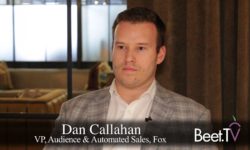Managing advertiser’s television spending and ad frequency at the same time in the OTT world is still quite complicated. “It is very disparate and there are a lot of different options. We’re not looking at a singular GRP anymore,” says Horizon Media’s Samantha Rose.
Despite early skepticism about the potential for ad-supported OTT services, they continue to emerge and find consumer acceptance, the SVP of Video Investment & Horizon Advanced says in this interview with Beet.TV. But OTT is far from being fully penetrated.
“All of those things aggregated together are at scale, but many people only have one service or two services and we know many people don’t even have an OTT device in their home yet.”
So it’s still far easier to manage ad spending and frequency with traditional linear TV, according to Rose. “It’s much harder to do that in the OTT environment.”
Horizon looks at OTT in two ways, first being a traditional content play. “We need to buy This Is Us whenever somebody’s watching This Is Us. We want to capture the This Is Us consumer,” Rose says. Then there’s the ability to more precisely target certain viewing segments and buy through a “digital lens” and “managing those two buys together.
She cites data overload as a particularly high hurdle, even for something as seemingly simple as targeting audiences based on household income. “There’s many different ways that you can get at that, and which is the most valid way of doing that.”
With many tools for measuring front- and back-end campaign elements, Rose is eager to see the syndication this fall of Nielsen’s Total Content Ratings. “We think that’s going to help us wrap our arms a little bit better around the true potential reach of OTT, whereas before it’s kind of been a little bit of a black box.”
Asked about ad loads on OTT and linear, she anticipates an “evening out” for the viewing experiencer. “But we’re a long way from that.”
While interactive TV has been around for a long time from the likes of TiVo, improved technology and remote-control usage are making it more seamless to navigate, according to Rose.
She acknowledges that addressable TV has its advantages but many advertisers still want to reach mass audiences for broad reach and brand building. By focusing too narrowly on audience segments “you’re maybe missing out on your future customer.”
This videos is part of a series about the emergence of OTT as an advertising platform, For more interviews, please visit this page. This series is presented by Premion.










































